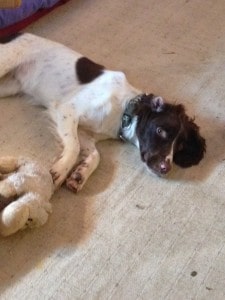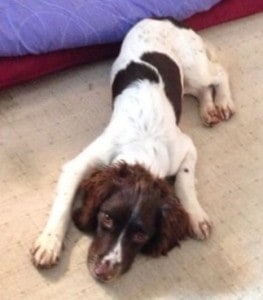I had no plans to get a new dog at the beginning of this year at all. I was thinking that maybe towards the end of 2014 I’d start looking for a young female working cocker, either looking for rescue or even start researching breeder. You know what they say about the best laid plans….
Less than 10 hours into 2014 I’d seen a video of a young working springer on facebook and was already in touch with the vet nurse looking after her to see whether she might fit in with our household. So by 2nd January we had driven to Bristol, picked up the springer looking for a home and brought her home. Here is Fraggle.
Now I’m not advocating this seemingly spur of the moment type of decision when getting a dog – not at all. But for our family who had been through the loss of our dear girlie GSD, Willow, in November and had been talking and looking for a young female working spaniel type for a few years this wasn’t so spur of the moment as it might seem.
I thought I’d write a post about what bringing this small, bright, fast spaniel into Tails We Win HQ means for us all, and what type of things I start training for at the start.
She was brought into another branch of the veterinary group to be put to sleep. Fortunately for us, the vet who saw Fraggle could find no medical reason to do so and persuaded the couple who took her in to sign her over to the custody of the vet practice so they could rehome her. It was a only a couple of days later that I saw the video on Facebook. We have discovered that Fraggle is a little older than suspected – 16 months as opposed to the 9-12 months we first thought. She is a very dainty springer, but was also very underweight when she first arrived at the vets and so more difficult to age, however all dogs can be hard to age accurately once they have adult teeth. We are lucky that we were able to obtain a date of birth via her microchip so we can be fairly sure of her age now. As Fraggle is fully grown at 16 months I do not need to be so concerned about how much exercise she gets like I would if she were still growing – although at the moment I need to take into account her health due to weight etc.
One of the first things to teach any dog but especially a working type is an “off switch” or settle. Fraggle was actually not too bad at this from the start, but she wouldn’t be able to remain settled if anything else was going on. Encouraging your dog to settle is really quite simple – reinforce your dog for settling down whenever and wherever they do it! It might be simple but it isn’t that easy, we humans are not brilliant at noticing when our dogs are doing something we like – we notice what we don’t want them to be doing much more easily. To help me I have treat pots in every room near where I will be most likely sitting, this way I always have something to hand. I mark Fraggle (with a clicker or a verbal marker word) and throw her a treat when she is settled – or doing anything else I’d like her to do more of. So if she settles on the bed in the living room whilst I’m working, or if she finds an appropriate toy to chew on quietly, or if she interacts appropriately with any of my other dogs, or if she goes into her crate, is quiet when there is a knock on the door etc. I try to make sure that every single time she does something I will want her to do again she is reinforced for it. In this way I have been able to ignore the not so brilliant things she did, they disappeared of their own accord because she spends far more time doing things that pay off and isn’t left time to do things like chew on the remote (I swapped for something more appropriate and made doubly sure she got treats for chewing on her own toys), or dragging the water bowl around and spilling it everywhere (I redirected onto a toy, made the bowl harder to move and again reinforced her for playing with toys rather than water bowls).
In a very short space of time Fraggle has become really very easy to live with. Our biggest indoors issue is housetraining. Fraggle wasn’t housetrained at all, in any way. To deal with this is again simple, but not necessarily easy!
My top tips for housetraining any dog, whether a puppy or older dog are as follows:
1) Watch them! The whole time your puppy/dog is awake and free to move around you need to be watching what they are doing and be ready to whisk them outside should it look like they are about to toilet (sniffing, circling, just about to squat…..)
2) If you can’t watch them, use a crate. If you cannot supervise because you are cooking, having a shower or whatever, pop your puppy/dog into their crate. This is not an excuse for confining your dog for hours on end, this is about short term confinement when you cannot be attentive enough to prevent mistakes. If you are leaving your dog unsupervised for a longer time then accept you are likely to get accidents and confine them to a safe area which is easy to clean but affords them space to move about and play whilst you are gone.
3) Reinforce for toileting in the right place. EVERY TIME. Your dog has no internal need to toilet on grass over the carpet, it makes no difference to him, so you need to make it worth his while to have a preference!
4) Teach a toileting cue: When your dog is just about to toilet, say your cue, then reinforce once they’ve finished. Repeat this each time and soon you’ll be able to cue them to toilet which helps prevent accidents when you are out as you can get your dog to empty before you leave them.
5) Ignore any accidents. Clean it up, move on. It was your mistake anyway – why weren’t you watching?!
6) Don’t use newspaper or puppy pads or anything that may encourage your dog to toilet in the house, even when you are leaving them for a while. You don’t want to confuse the issue by sometimes encouraging them to go inside, and at other times outside. Get it right from the start.
7) Something that you may wish you had taught: teach your dog to toilet both on/off lead, on different surfaces etc. you never know when you might need them to toilet on concrete whilst on lead. If they have only ever toileted off lead on the grass in your garden they may well end up only ever toileting there.
With older or adult dogs that have never seemingly been housetrained the process may take longer than with a new puppy, however if you are vigilant it won’t take long for your dog to cotton on. A few weeks in and Fraggle will ask to go out, if I miss the ask however we can still get accidents but those are obviously totally my fault for not paying close enough attention. They are few and far between though so I know we are getting there.
I’m not too bothered about teaching things like walking to heel in any formal way as I use a TTouch technique of two points of contact to help a dog walk in balance rather than pull – more in another installment on that.
Recall however is very important for me and that was our next mission – see the next blog post to find out how I deal with the recall.


